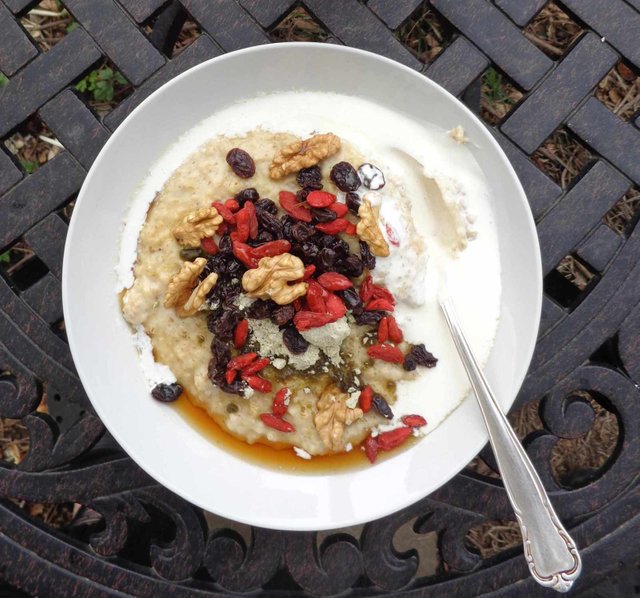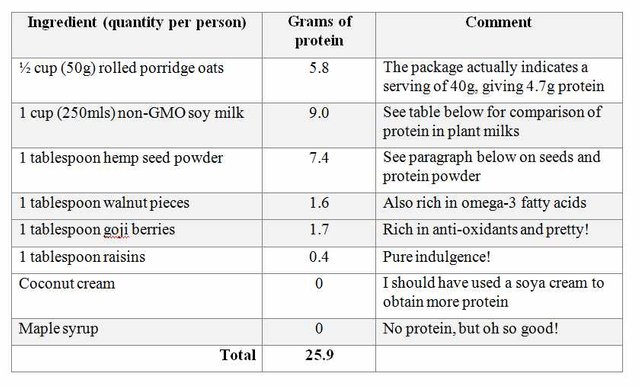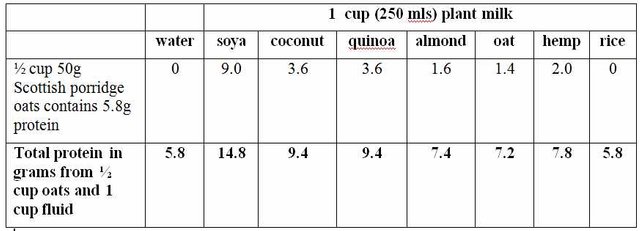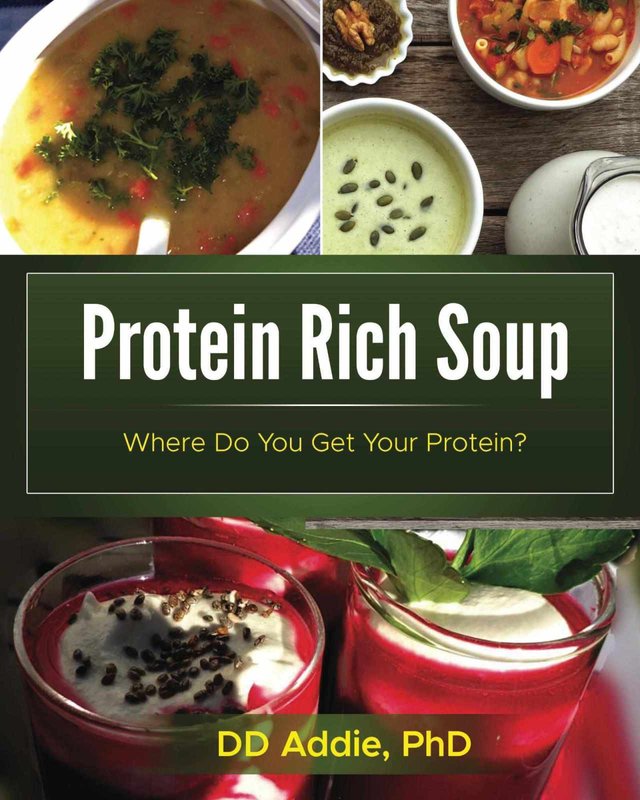Maximising the protein in Scottish Porridge / Oatmeal
This bowl of porridge contains 25.9g protein—want to know how? Read on.


Steel cut oats have a better glycemic index than do rolled oats, but I prefer the creamier texture of the latter over the chewier texture of steel cut oats. According to my own personal favourite porridge manufacturer—Nairn’s of Scotland —one serving of their Scottish Porridge Oats contains 4.7g of protein. Nairn’s definition of a serving is 40 grams, which is less than I use: I use a half cup for me, which contains 50g and a whole cup for my husband. Oats are rich in soluble fibre and also contain manganese, phosphorous, magnesium, zinc, iron, folate, vitamin B6 and thiamin.
Making porridge on the cooker
Fill ½ cup with oats (for 1 person, a full cup for two people) and put into a non-stick saucepan. Use the same cup to obtain twice as much of the plant milk of your choice, or water. Stir with a wooden spoon. Bring to the boil, stirring regularly and simmer for 4-5 minutes.
Making porridge in a microwave
For each serving, fill ½ cup with oats (for 1 person, a full cup for two people) and put into a deep, microwaveable, dish (glass is preferable to plastic, since some plastics leach hormone-disrupting chemicals). Use the same cup to obtain twice as much of the plant milk of your choice, or water. Stir well and microwave on either power level 700W for 3 minutes or 900W for 2 minutes. Stir halfway through cooking time.
Serve with the following for extra protein
Nuts: e.g. walnuts, pistachios, almonds
Seeds: e.g. sunflower, pumpkin, hemp, chia, sesame
You can use whole seeds instead of hemp protein powder, if you prefer: a tablespoon of hemp seeds will give you 5.1 grams of protein. (See the table below for seed protein content.) I find hemp seed protein powder the most palatable of the plant-based protein powders. Don’t use whey or casein protein powders unless you really would love to die of cancer. Whey is also absorbed quickly; earlier research examining whole body protein kinetics showed that concomitant oxidation of some of the amino acids may result in a lower net protein balance when compared to a protein source that is absorbed at a slower rate [Schoenfeld and Aragon, 2018]. See the table below for protein content.

Serve with the following for deliciousness
- Maple syrup or honey
- Coconut cream
- Fresh organic fruit, e.g. chopped apples, blueberries, raspberries, strawberries, peaches, nectarines
- Dried fruit: raisins, dates, goji berries
- A sprinkling of cinnamon
- Stir half a tablespoon of cacao powder into the porridge when you are cooking it for chocolate porridge. Cacao and cocoa powders do contain a little protein.
No, those are NOT rabbit turds on my porridge: they’re raisins.* The red berries are goji berries. It’s March at time of writing, so there are no fresh organic berries in my garden or the shops yet—when they appear, I’ll use fresh berries, though probably on muesli, which I prefer in summertime. I like porridge in the winter because it is more warming than muesli. (* Eating rabbit turds might be good for my microbiome: rabbits are coprophagic (they eat their own poo) to reclaim valuable bacteria and vitamins which would otherwise be lost (admittedly they don’t eat the little hard raisin-like turds, they eat softer ones). However, I think I’ll stick to getting my probiotics from live, Bifidus soy yoghurt and leave the turd-eating to my rabbits. )
Choosing a high protein plant milk for your porridge
We have been taught from childhood that milk is the perfect food—this is only true if you are a calf, and need to gain 230 kg (500 lb) in 6 months! I don’t want to stink up my breakfast with cow’s milk and cream: even though, undeniably, these are delicious and they do contain protein, but the protein is casein which acts like a manure on the weeds of cancer cells, encouraging them to flourish and grow. Cow’s milk and cream also contain artery clogging fats, and breast and prostate cancer inducing hormones.

How much protein should we eat at breakfast?
A protein rich breakfast is recommended for weight loss and also counters anxiety. In his book, 12 Rules for Life, Dr Jordan B. Petersen wrote, “I counsel my clients to eat a fat and protein-heavy breakfast as soon as possible after they awaken. … I have had many clients whose anxiety was reduced to subclinical levels merely because they started to sleep on a predictable schedule and eat breakfast.”
But what constitutes a high protein breakfast? How much protein, exactly, should be in our breakfast? The optimal amount appears to be about 20-25 grams, [Areta et al, 2013]: if you eat too much protein, it will be broken down into toxic urea, which will acidify the body and ultimately lead to osteoporosis as calcium is removed from your bones to balance your body’s pH. In the memorable words of Dr Michael Greger in his book Carbophobia, you will be “Peeing your bones down the toilet.”
Schoenfeld and Aragon [2018] begin their scientific paper thus: “Controversy exists about the maximum amount of protein that can be utilized for lean tissue-building purposes in a single meal for those involved in regimented resistance training. It has been proposed that muscle protein synthesis is maximized in young adults with an intake of ~ 20-25 g of a high-quality protein; anything above this amount is believed to be oxidized for energy or transaminated to form urea and other organic acids. However, these findings are specific to the provision of fast-digesting proteins without the addition of other macronutrients. Consumption of slower-acting protein sources, particularly when consumed in combination with other macronutrients, would delay absorption and thus conceivably enhance the utilization of the constituent amino acids.”
They conclude their abstract with “The preponderance of data indicate that while consumption of higher protein doses (> 20 g) results in greater amino acid oxidation, this is not the fate for all the additional ingested amino acids as some are utilized for tissue-building purposes.”
This high protein oatmeal keeps you full for several hours
In my attempts to switch from vegetarian to vegan, I was often hungry all day: when I eat this porridge the satiety lasts me hours. My efforts to get enough plant-based protein were the reasons I wrote my book “Protein Rich Soup.”

The milk and seed protein tables were adapted from my book, Protein Rich Soup, available from Amazon. https://www.amazon.com/Protein-Rich-Soup-gluten-free-plant-based-ebook/dp/B0784H4PQ4/ref=sr_1_1?ie=UTF8&qid=1521292608&sr=8-1&keywords=protein+rich+soup
Please upvote my blog and subscribe.
References
Addie DD. 2017, Protein Rich Soup.
Areta JL, Burke LM, Ross ML, Camera DM, West DW, Broad EM, Jeacocke NA, Moore DR, Stellingwerff T, Phillips SM, Hawley JA, Coffey VG. Timing and distribution of protein ingestion during prolonged recovery from resistance exercise alters myofibrillar protein synthesis. J Physiol. 2013 May 1;591(9):2319-31.
Greger, Michael. 2005. Carbophobia: The Scary Truth About America's Low-carb Craze. USA. Also see: www.atkinsexposed.org.
Jordan B Peterson. 12 Rules for Life: An Antidote to Chaos, (Allen Lane) page 18
Schoenfeld BJ, Aragon AA. How much protein can the body use in a single meal for muscle-building? Implications for daily protein distribution. J Int Soc Sports Nutr. 2018 Feb 27;15:10